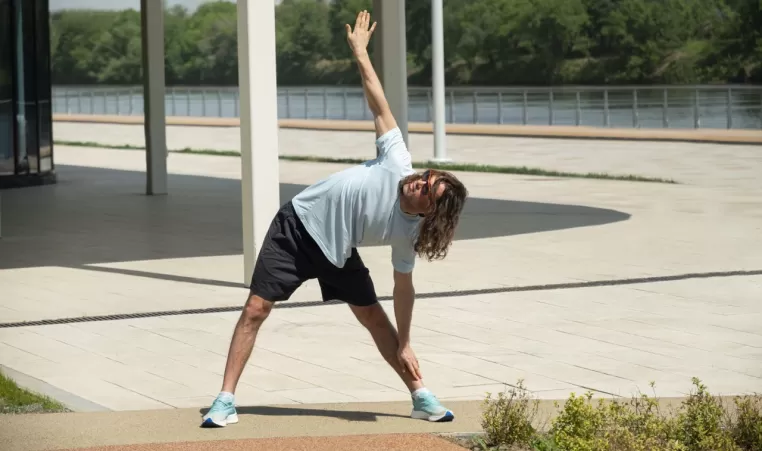
You've made it to the Y, with a rocking playlist and a full water bottle. You're all set to hit the treadmill or lift some weights.
But before you press 'start,' let’s ask a quick question.
Do you, like many of us, jump straight into the main event?
If you’re skipping your warm-up and bolting right after your last rep, you’re missing out on the most important 'bookends' of your fitness routine.
We get it—time is precious. However, dedicating just 5-10 minutes to the right kind of stretching before and after your workout is a total game-changer.
Before Your Workout: Get Dynamic
What is dynamic stretching?
It’s simply stretching through movement. Think active, fluid motions that gently take your joints and muscles through their full range of motion. Instead of holding a pose, you’re actively warming up your body for the work it’s about to do.
Think of your muscles like a rubber band. If you try to stretch a cold, stiff rubber band, it’s more likely to snap. But if you warm it up a little, it becomes limber and stretchy.
Here are some key benefits of a pre-workout dynamic stretch:
-
Wake Up Your Muscles: Dynamic movements get your heart rate up and increase blood flow. This delivers warm, oxygen-rich blood to the muscles you’re about to use, making them more efficient and ready for action.
-
Improves Your Movement: By actively moving your joints, you’re essentially "greasing the hinges." This improves your immediate range of motion, allowing you to squat deeper, lunge longer, and move more effectively during your workout.
-
Boosts Your Performance: Studies have shown that warming up with dynamic stretches can help you generate more power and perform better, especially in activities that require quick or explosive movements.
-
Helps Prevent Injury: This is the big one. Warm, pliable muscles are far less likely to strain or tear than cold, stiff ones.
Some ideas for dynamic stretches:
Try doing each of these movements for about 30-45 seconds.
-
Leg Swings (Forward and Sideways): Hold onto a stable surface and swing one leg forward and backward like a pendulum. Then, turn and swing it side-to-side. This is fantastic for opening up your hips.
-
Arm Circles: Stand with your feet shoulder-width apart and make big circles with your arms, first forward, then backward. Start with small circles and gradually make them bigger.
-
Torso Twists: Stand with your feet a little wider than your shoulders and your arms out to the sides. Gently twist your upper body from side to side, keeping your hips facing forward.
-
High Knees: March or jog in place, bringing your knees up toward your chest with each step.
-
Butt Kicks: March or jog in place, trying to kick your heels toward your glutes.
-
Walking Lunges: Step forward into a lunge, keeping your front knee aligned with your ankle. Push off and step into the next lunge with the opposite leg.
After Your Workout: Static Stretches
You crushed your workout. You’re feeling tired but accomplished. Before you grab your keys and run, take some time for static stretching.
This is the type of stretching you’re probably more familiar with—holding a specific stretch for a period of time, usually 15-60 seconds.
After a workout, your muscles are warm and receptive to a good, long stretch. This is where you can make real gains in your flexibility and help your body kickstart the recovery process.
Here are some key benefits of a POST-workout static stretch:
-
Improves Long-Term Flexibility: Consistently holding stretches after your workout, when your muscles are most pliable, can lead to significant improvements in your overall flexibility and range of motion over time.
-
Promotes Relaxation: Holding a gentle stretch can help release the tension that builds up in your muscles during a tough workout. It’s a great way to signal to your body and mind that it’s time to cool down and relax.
-
Aids in Recovery: Stretching helps keep the blood flowing to your muscles even after your workout is over. This helps deliver the nutrients needed for repair and clears out the metabolic waste produced during exercise.
Some ideas for static stretches:
Hold each of these stretches for 15-60 seconds. Remember to breathe, and never stretch to the point of pain. It should feel like a gentle pull, not a sharp strain.
-
Hamstring Stretch: Sit on the floor with one leg straight out and the other bent, with the sole of your foot against your inner thigh. Gently lean forward over the straight leg until you feel a stretch.
-
Quad Stretch: Standing (hold onto something for balance if needed), grab your right foot and gently pull your heel toward your glute, feeling the stretch in the front of your thigh.
-
Triceps Stretch: Reach one arm over your head and bend it at the elbow, letting your hand fall down your back. Use your other hand to gently pull the elbow to deepen the stretch.
-
Chest Stretch: Find a doorway or a corner of a wall. Place your forearm on the frame with your elbow bent at 90 degrees. Gently step forward until you feel a stretch across your chest and the front of your shoulder.
-
Calf Stretch: Stand facing a wall and place your hands on it for support. Step one foot back, keeping the leg straight and the heel on the floor. Gently lean forward until you feel a stretch in your calf.
So, the next time you're at the Marshall Area YMCA, remember the "bookends." A few minutes of dynamic stretching to warm up and some gentle static stretches to cool down isn't just about improving that day's workout—it's an investment in your long-term health, mobility, and fitness journey.
Feeling unsure where to start? Just ask one of our wellness staff. We’re always happy to show you a few great stretches for your routine.